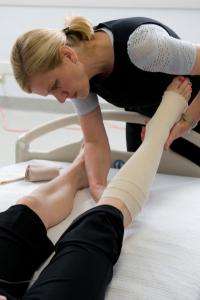3L tubular bandaging significantly improves healing of chronic wounds, study finds

(Medical Xpress)—A characteristically inflamed, weeping sore that fails to heal, heals slowly or tends to recur is known as a chronic wound, a common debilitating and painful medical condition which requires specialist care.
Compression bandages have been shown to significantly improve healing of the most common and incapacitating chronic wound problem known as Venous Leg Ulcers (VLUs). VLUs are caused mostly by an underlying disease known as chronic venous insufficiency (CVI), where veins in the legs lose the ability to pump oxygenated blood efficiently and the effects become visible on the leg in the form of a painful, malodorous wound.
For the first time new research, published in international journal Wound Repair and Regeneration, has examined compression bandaging contrasting the effectiveness of the 'sock-like' three-layer (3L) tubular compression bandage with standard single layer bandages in the treatment of venous leg ulcers in Victorian and Queensland hospital clinics.
The study, led by Dr Carolina Weller from Monash University's Department of Epidemiology and Preventive Medicine, found 3L tubular bandaging significantly improved healing, minimised recurrence of the wound and was more affordable than standard single layer bandages.
Dr Weller said VLUs were a significant yet under represented burden to patients and healthcare professionals, affecting the elderly and patients aged from their 40's due to the rise in obesity, diabetes, and other chronic diseases, which are known causes of CVI.
"The adequate management of venous leg ulcers represents a significant clinical problem. Currently, there are a number of barriers preventing adequate treatment, including affordability of compression, knowledge of application by nurses and patient adherence to keep a tight bandage on despite pain or discomfort," Dr Weller said.
"Without compression, a wound simply will not heal. Our study found the three-layer bandage was easier to apply and patients reported it was a comfortable alternative to standard compression bandages, which were costly and potentially less successful at healing due to lower patient adherence."
Dr Weller said in Victoria there was currently no subsidy available in the treatment of VLU and the burden of cost was a major issue.
"We found the cost of the three-layer tubular bandage, including application by a nurse, was almost halved in comparison to the more commonly used standard control compression bandage," Dr Weller said.
"If you consider the burden of disease beyond cost alone, it can have debilitating effects. Some patients suffer with a lot of pain and cannot go to work or exercise and some often feel a sense of social isolation as a result.
"This research will help clinicians better manage people with VLUs and ensure they comply with evidence based management guidelines."















